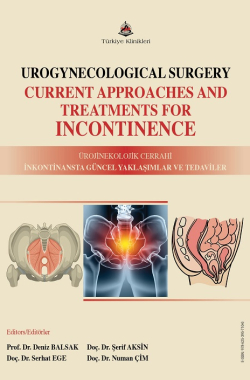PERSONALIZED UROGYNECOLOGICAL STRATEGIES AND PATIENT-CENTRIC SURGICAL SELECTION
Gizem Boz İzceyhan
University of Health Science, Zeynep Kamı̇l Women and Children Dı̇ seases Tranı̇ng and Research Hospital, Department of Gynecology and Obstetrics, İstanbul, Türkiye
Boz İzceyhan G. Personalized Urogynecological Strategies and Patient-Centric Surgical Selection. In: Balsak D, Çim N, Ege S editors. Urogynecological Surgery Current Approaches and Treatments for Incontinence. 1st ed. Ankara: Türkiye Klinikleri; 2025. p.359-364.
ABSTRACT
Pelvic floor disorders are complex conditions that profoundly affect women?s quality of life, with surgical interventions often serving as primary therapeutic options. In common disorders such as pelvic organ prolapse (POP) and stress urinary incontinence (SUI), treatment success should not be defined solely by anatomical correction but also by the extent to which individual goals, quality of life, and patient satisfaction are achieved. Recent years have witnessed a paradigm shift toward patient-centered approaches, particularly the adoption of shared decision-making (SDM), which has become an essential component of contemporary urogynecological practice. This model facilitates patients? understanding of treatment options, clarifies their preferences, and strengthens physician-patient collaboration. The literature provides robust evidence that the use of decision-support tools enhances patient satisfaction, improves comprehension, and increases adherence to treatment plans. Surgical decision-making should carefully integrate individual factors such as age, comorbidities, fertility desires, sexual activity, and prior surgical history. Furthermore, uterus-preserving techniques, minimally invasive approaches, and strategies that align with patient expectations represent critical determinants of clinical success. Long-term follow-up emphasizes that success should be assessed not merely by recurrence or anatomical outcomes but also through quality-of-life measures and the degree to which personal goals are achieved. Instruments such as the Pelvic Floor Distress Inventory (PFDI-20), Pelvic Floor Impact Questionnaire (PFIQ-7), Incontinence Impact Questionnaire (IIQ), and Goal Attainment Scaling (GAS) provide structured frameworks for evaluating these outcomes. Collectively, these findings underscore that individualized surgical planning, rooted in holistic and patient-centered principles, significantly enhances therapeutic efficacy and long-term patient satisfaction. Such approaches highlight not only the ethical necessity of incorporating patient values into surgical decision-making but also the clinical advantage of achieving superior outcomes. Ultimately, integrating patient-defined success metrics, functional improvements, and psychosocial benefits into surgical algorithms?supported by multidisciplinary collaboration?offers a comprehensive strategy that elevates the quality and effectiveness of urogynecological care.
Keywords: Precision medicine; Patient participation; Quality of life
Kaynak Göster
Referanslar
- Hullfish KL, Bovbjerg VE, Gibson J, Steers WD. Patient-centered goals for pelvic floor dysfunction surgery: What is success, and is it achieved? Am J Obstet Gynecol. 2002;187(1):88-92. [Crossref] [PubMed]
- Hullfish KL, Bovbjerg VE, Gurka MJ, Steers WD. Surgical versus nonsurgical treatment of women with pelvic floor dysfunction: Patient centered goals at 1 year. J Urol. 2008;179(6):2280-2285; discussion 2285. [Crossref] [PubMed] [PMC]
- Haya N, Feiner B, Baessler K, Christmann-Schmid C, Maher C. Perioperative interventions in pelvic organ prolapse surgery. Cochrane Database Syst Rev. 2018;8(8):CD013105. [Crossref] [PubMed]
- Fritel X, Ravit M, Pizzoferrato A-C, et al; PROSPERE Team. Do surgeons anticipate women's hopes and fears associated with prolapse repair? A qualitative analysis in the PROSPERE trial. J Clin Med. 2023;12(4):1332. [Crossref] [PubMed] [PMC]
- Barber MD. Pelvic organ prolapse. BMJ. 2016;354:i3853. [Crossref] [PubMed]
- Maher C, Feiner B, Baessler K, Christmann-Schmid C, Haya N, Brown J. Surgery for women with apical vaginal prolapse. Cochrane Database Syst Rev. 2016;10(10):CD012376. [Crossref] [PubMed] [PMC]
- Drost LE, Stegeman M, Gerritse MBE, et al; SHADE-POP Study Group. A web-based decision aid for shared decision making in pelvic organ prolapse: The SHADE-POP trial. Int Urogynecol J. 2023;34(1):79-86. [Crossref] [PubMed] [PMC]
- Athey R, Bugeja R, Jones G, Jha S. Impact of patients decision aids on shared decision-making and patient satisfaction prior to pelvic floor surgery. BJOG. 2025;132(7):918-926. [Crossref] [PubMed] [PMC]
- Rotem R, Galvin D, Daykan Y, Al-Shukaili S, O'Reilly BA, O'Sullivan OE. Precision in practice: The critical role of mesh and procedure type specification in urogynecological surgeries and research. Int Urogynecol J. 2024;35(9):17631767. [Crossref] [PubMed] [PMC]
- St Martin B, Markowitz MA, Myers ER, Lundsberg LS, Ringel N. Estimated national cost of pelvic organ prolapse surgery in the United States. Obstet Gynecol. 2024;143(3):419-427. [Crossref] [PubMed]
- Chang OH, Walters MD, Yao M, Lapin B. Development and validation of the Value of Uterus instrument and visual analog scale to measure patients' valuation of their uterus. Am J Obstet Gynecol. 2022;227(5):746.e1-746.e9. [Crossref] [PubMed]
- Geynisman-Tan J, Kenton K. Surgical updates in the treatment of pelvic organ prolapse. Rambam Maimonides Med J. 2017;8(2):e0017. [Crossref] [PubMed] [PMC]
- Ajimi Y, Sasaki M, Uchida Y, Kaneko I, Nakahara S, Sakamoto T. Primary triage in a mass-casualty event possesses a risk of increasing informational confusion: A simulation study using Shannon's entropy. Prehosp Disaster Med. 2016;31(5):498-504. [Crossref] [PubMed]
- Srikrishna S, Robinson D, Cardozo L, Thiagamoorthy G. Patient and surgeon goal achievement 10 years following surgery for pelvic organ prolapse and urinary incontinence. Int Urogynecol J. 2015;26(11):1679-1686. [Crossref] [PubMed]
- Elkadry EA, Kenton KS, FitzGerald MP, Shott S, Brubaker L. Patient-selected goals: A new perspective on surgical outcome. Am J Obstet Gynecol. 2003;189(6):1551-1557; discussion 1557-1558. [Crossref] [PubMed]
- Turner-Stokes L. Goal attainment scaling (GAS) in rehabilitation: A practical guide. Clin Rehabil. 2009;23(4):362-370. [Crossref] [PubMed]
- Whiteside JL, Johnson JD, Spratt KF. Goals, symptoms, signs, and treatments among women with pelvic floor disorders. Female Pelvic Med Reconstr Surg. 2014;20(2):104-110. [Crossref] [PubMed]
- Robinson MO, Linder BJ. Evaluation and treatment of pelvic organ prolapse. Minerva Med. 2023;114(4). [Crossref] [PubMed]
- Robinson D, Prodigalidad LT, Chan S, et al. International Urogynaecology Consultation Chapter 1 Committee 4: Patients' perception of disease burden of pelvic organ prolapse. Int Urogynecol J. 2022;33(2):189-210. [Crossref] [PubMed]
- Marques F, Josloff K, Hung K, Wakamatsu M, Sepucha KR. Decision aids and shared decision making in urogynecology. Menopause. 2021;29(2):178-183. [Crossref] [PubMed]
- Sung VW, Wohlrab KJ, Madsen A, Raker C. Patient-reported goal attainment and comprehensive functioning outcomes after surgery compared with pessary for pelvic organ prolapse. Am J Obstet Gynecol. 2016;215(5):659.e1-659.e7. [Crossref] [PubMed] [PMC]

